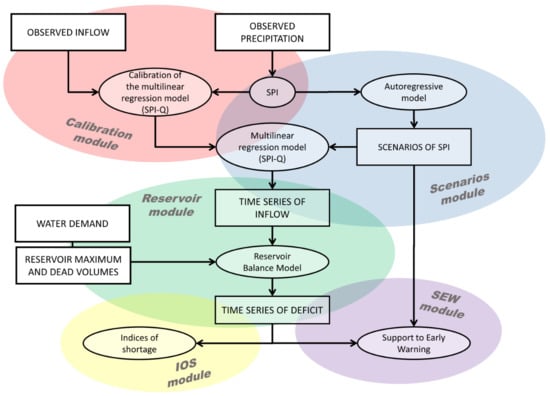A Stakeholder Oriented Modelling Framework for the Early Detection of Shortage in Water Supply Systems
Abstract
:1. Introduction
2. Materials and Methods
2.1. Methodological Framework
- Variables of interest and results, for climate, hydrological and water management analysis should be expressed in terms of normalized indices, easily understandable by stakeholders and policy-makers to allow for comparisons among different the basins and WSSs or sub-systems. Among them, the Standardized Precipitation Index (SPI, [45]) to characterize the meteorological drought is preferred [46,47].
- The whole procedure must relate directly to meteorological drought indices and severity indices (i.e., ability to meet demands) as impact metrics.
- Simple basin scale rainfall-discharge models are necessary where a climate monitoring network is poor, especially in the upper part of a river basin, provided that such models are able to reproduce the dynamic of the system due to climate variability. Model simplicity (both in operative handling and in calibration procedures) enables the implementation and comprehension of the hydrological tools required for non-expert users. This is a key point in a participatory management framework [14].
- The precipitation and hydrological time series used to estimate water resource availability must be representative of the characteristic return periods of shortage events. For this reason, a stochastic approach should be preferred.
- A multilinear regression model, named SPI-Q, to simulate the relationships between the precipitation regime, represented by SPIs computed over different time scales and the monthly inflow to the reservoir (Section 2.1.1).
- A stochastic model for the monthly SPI based on a zero-mean autoregressive (AR) model to generate a long-enough time series (Section 2.1.2).
- A monthly water balance model of the reservoir that accounts for the storage of the reservoir, the inflows and outflows connected to the water demands, environmental flows, and flood control spillages (Section 2.1.3).
- Suitable indices of shortage able to represent not only the mean failure conditions, but also the “extreme” failures (i.e., with longer return periods), less likely, but potentially more dangerous (Section 2.1.4).
- Statistical methods for a quantitative analysis of the past precipitation regime, represented by the SPIs and the future conditions of shortage, assessed over different forecast time scales (Section 2.1.5).
2.1.1. CALIBRATION Module
2.1.2. SCENARIOS Module
2.1.3. RESERVOIR Module
2.1.4. Indices of Shortage (IOS) Module
2.1.5. Support to Early-Warning (SEW) Module
2.2. Case Studies
- Lake Maggiore natural reservoir is located in the Alpine region between Switzerland and Italy. Its level is regulated by law through hydraulic infrastructures that make the total amount of water usable for irrigation and industrial purposes equal to 420 mm3 from March to October and to 315 Mm3 from November to February. The total demand ranges from approximately 250 Mm3/month in winter to 650 Mm3/month in summer (irrigation season). The monthly precipitation regime presents two peaks: the spring’s peak is due to both rainfall and snowmelt, while the autumn’s peak appears to be related only to precipitation. Moreover, the base-flow ensures a consistent discharge also during the summer months.
- Ridracoli artificial reservoir. Located in the Tosco-Emilian Apennine chain (central Italy), it can be considered a small size reservoir (28 Mm3). The mean monthly demand (only for human consumption) is about 5 Mm3/month. The strong increase due to the touristic season is usually supplied by other water resources (in particular, coastal aquifers). In this basin, most of the precipitation occurs in late autumn, winter, and early spring. The inflow to the reservoir shares approximately the same regime and almost nullifies during the summer months.
- Occhito artificial reservoir, located in the Molise region (south of Italy) can be considered a big-size reservoir, with a maximum storage capacity of 250 Mm3. The mean annual withdrawal from the Occhito dam for the irrigation supply of the Fortore irrigation district is about 95.9 Mm3 (varying seasonally), while the annual demand for human and industrial consumption are respectively about 55 and 10 Mm3 [49,51]. The precipitation regime is similar to the one observed in Ridracoli, with most of the rainfall concentrated in late autumn, winter, and early spring. Such a precipitation regime appears to drive the inflow to the reservoir regime.
3. Results and Discussion
3.1. Calibration
3.2. Scenarios
3.3. Reservoir
3.4. Indices of Shortage (IOS)
3.5. Support to Early-Warning (SEW)
4. Conclusions
- The calibration procedure performed through the SPI-Q model is based only on precipitation and discharge data. The minimal number of parameters along with the self-calibration procedure allows the implementation and comprehension of the hydrological model also by non-expert users. Moreover, although it is statistically-based, it maintains the physical meaning of the parameters. Despite model simplicity, the simulations performed on the three Italian case studies showed the goodness of the method for studying occurrence of failures.
- The method adopted to generate scenarios allows for the simulation of a discharge time series based on both the time series of precipitation (i.e., from medium term weather forecast) and directly on the Standardized Precipitation Indices time series, which is particularly useful when implementing climate change scenarios from a General Circulation Models (GCM) output. The main limit of the proposed approach relies on the basic assumption that catchment response to the precipitation regime is time invariant.
- A new formulation of the reliability-resilience-vulnerability metrics has been tested on the three case studies (a previous discussion on this new formulation solely on the case of the Ridracoli reservoir can be found in [49]). The use of standardized indices allowed for a quick comparison among water systems regardless of the differences in size, climate, meteorological, and hydrological regimes of the basins and reservoirs.
- The Support to Early-Warning procedure relates the precipitation regime, represented by the SPI at different time scales, to the simulated deficit volumes computed over the m following months. This kind of representation allows a user to qualitatively identify possible early-warnings by analyzing the antecedent precipitation conditions that can potentially lead to shortage conditions over a future time window assigned by the user. A quantitative method to analyze the output from the SEW module and to identify possible “management triggers” is proposed. It is based on the Cohen’s coefficient and allows for ranking the predictor in terms of antecedent precipitation (SPI) and forecast time scale. Possible management options based on different future water allocation schemes (both in time and quantity) can be suggested based on the linear regression of the forecasted deficit versus the antecedent standardized precipitation indices.
Author Contributions
Funding
Acknowledgments
Conflicts of Interest
References
- European Commission. Water Scarcity and Droughts Expert Network Drought Management Plan Report; Including Agricultural, Drought Indicators and Climate Change Aspects; Technical Report; EU: Maastricht, The Netherlands, 2008. [Google Scholar]
- Karavitis, C.A.; Tsesmelis, D.E.; Skondras, N.A.; Stamatakos, D.; Alexandris, S.; Fassouli, V.; Vasilakou, C.G.; Oikonomou, P.D.; Gregorič, G.; Grigg, N.S.; et al. Linking drought characteristics to impacts on a spatial and temporal scale. Water Policy 2014, 16, 1172–1197. [Google Scholar] [CrossRef]
- Wang, D.; Hejazi, M.; Cai, X.; Valocchi, A.J. Climate change impact on meteorological, agricultural, and hydrological drought in central Illinois. Water Resour. Res. 2011, 47, W09527. [Google Scholar] [CrossRef]
- Van Loon, A. Hydrological drought explained. WIREs Water 2015, 2, 359–392. [Google Scholar] [CrossRef] [Green Version]
- Lopez-Moreno, J.; Vicente-Serrano, S.; Beguerıa, S.; Garcıa-Ruiz, J.; Portela, M.; Almeida, A. Downstream propagation of hydrological droughts in highly regulated transboundary rivers: The case of the Tagus river between Spain and Portugal. Water Resour. Res. 2009, 45, W02405. [Google Scholar]
- Garrote, L.; Martin-Carrasco, F.; Flores-Montoya, F.; Iglesias, A. Linking Drought Indicators to Policy Actions in the Tagus Basin Drought Management Plan. Water Resour. Manag. 2007, 21, 873–882. [Google Scholar] [CrossRef]
- Hao, Z.; Hao, F.; Singh, V.P.; Xia, Y.; Ouyang, W.; Shen, X. A theoretical drought classification method for the multivariate drought index based on distribution properties of standardized drought indices. Adv. Water Resour. 2016, 92, 240–247. [Google Scholar] [CrossRef]
- Gustard, A.; Young, A.; Rees, G.; Holmes, M. Operational hydrology. In Hydrological Drought. Processes and Estimation Methods for Streamflow and Groundwater; Tallaksen, L., van Lanen, H.A.J., Eds.; Elsevier: Amsterdam, The Netherlands, 2004; pp. 455–498. [Google Scholar]
- Wilhite, D.A.; Hayes, M.J.; Svoboda, M.D. Drought monitoring and assessment: Status and trends in the United States. In Drought and Drought Mitigation in Europe; Vogt, J.V., Somma, F., Eds.; Kluwer Academic Publishers: Amsterdam, The Netherlands, 2000; pp. 149–160. [Google Scholar]
- Wilhite, D.A.; Svoboda, M.D.; Hayes, M.J. Understanding the complex impacts of drought: A key to enhancing drought mitigation and preparedness. Water Resour. Manag. 2007, 21, 763–774. [Google Scholar] [CrossRef] [Green Version]
- Svoboda, M.; LeComte, D.; Hayes, M.; Heim, R.; Gleason, K.; Angel, J.; Rippey, B.; Tinker, R.; Palecki, M.; Stooksbury, D.; et al. The drought monitor. Bull. Am. Meteorol. Soc. 2002, 83, 1181–1190. [Google Scholar] [CrossRef]
- Mens, M.J.P.; Gilroy, K.; Williams, D. Developing system robustness analysis for drought risk management: An application on a water supply reservoir. Nat. Hazard. Earth Syst. Sci. 2015, 15, 1933–1940. [Google Scholar] [CrossRef]
- Wu, W.; Maier, H.R.; Dandy, G.C.; Leonard, R.; Bellette, K.; Cuddy, S.; Maheepala, S. Including stakeholder input in formulating and solving real-world optimisation problems: Generic framework and case study. Environ. Model. Softw. 2016, 79, 197–213. [Google Scholar] [CrossRef]
- Voinov, A.; Kolagani, N.; McCall, M.K.; Glynn, P.D.; Kragt, M.E.; Ostermann, F.O.; Pierce, S.A.; Ramu, P. Modelling with stakeholders—Next generation. Environ. Model. Softw. 2016, 77, 196–220. [Google Scholar] [CrossRef]
- Giacomelli, P.; Rossetti, A.; Brambilla, M. Adapting water allocation management to drought scenarios. Nat. Hazard. Earth. Syst. Sci. 2008, 8, 293–302. [Google Scholar] [CrossRef] [Green Version]
- Westphal, K.S.; Laramie, R.L.; Borgatti, D.; Stoops, R. Drought management planning with economic and risk factors. J. Water Resour. Plan. Manag. 2007, 133, 351–362. [Google Scholar] [CrossRef]
- Giordano, R.; Preziosi, E.; Romano, E. Integration of local and scientific knowledge to support drought impact monitoring: Some hints from an Italian case study. Nat. Hazards 2013, 69, 523–544. [Google Scholar] [CrossRef]
- Giordano, R.; D’Agostino, D.; Apollonio, C.; Scardigno, A.; Pagano, A.; Portoghese, I.; Lamaddalena, N.; Piccinni, A.F.; Vurro, M. Evaluating acceptability of groundwater protection measures under different agricultural policies. Agric. Water Manag. 2015, 147, 54–66. [Google Scholar] [CrossRef]
- Wilhite, D.A. Drought Monitoring as a Component of Drought Preparedness Planning. In Coping with Drought Risk in Agriculture and Water Supply Systems. Drought Management and Policy Development in the Mediterranean; Iglesias, C.A., Garrote, L., Cancelliere, A., Cubillo, F., Wilhite, D.A., Eds.; Springer: Amsterdam, The Netherlands, 2009. [Google Scholar]
- Botterill, L.C.; Hayes, M.J. Drought triggers and declarations: Science and policy considerations for drought risk management. Nat. Hazards 2012, 64, 139–151. [Google Scholar] [CrossRef]
- Ceppi, A.; Ravazzani, C.; Corbari, C.; Meucci, S.; Pala, F.; Salerno, R.; Meazza, G.; Chiesa, M.; Mancini, M. Real Time Drought Forecasting System for Irrigation Management. Procedia Environ. Sci. 2013, 19, 776–784. [Google Scholar] [CrossRef]
- Hao, Z.; Hao, F.; Singh, V.P.; Ouyang, W.; Cheng, H. An integrated package for drought monitoring, prediction and analysis to aid drought modeling and assessment. Environ. Model. Softw. 2017, 91, 199–209. [Google Scholar] [CrossRef]
- Esfahanian, E.; Pouyan Nejadhashemi, A.; Abouali, M.; Adhikari, U.; Zhang, Z.; Daneshvar, F.; Herman, M.R. Development and evaluation of a comprehensive drought index. J. Environ. Manag. 2017, 185, 31–43. [Google Scholar] [CrossRef] [PubMed]
- Liu, Y.; Gupta, H.; Springer, E.; Wagener, T. Linking science with environmental decision making: Experiences from an integrated modeling approach to supporting sustainable water resources management. Environ. Model. Softw. 2008, 23, 846–858. [Google Scholar] [CrossRef]
- Preziosi, E.; Del Bon, A.; Romano, E.; Petrangeli, A.B.; Casadei, S. Vulnerability to drought of a complex water supply system. The upper Tiber basin case study (Central Italy). Water Resour. Manag. 2013, 27, 4655–4678. [Google Scholar] [CrossRef]
- Yan, D.; Weng, B.; Wang, G.; Wang, H.; Yin, J.; Bao, S. Theoretical framework of generalized watershed drought risk evaluation and adaptive strategy based on water resources system. Nat. Hazards 2014, 73, 259–276. [Google Scholar] [CrossRef]
- Weng, B.S.; Yan, D.H.; Wang, H.; Liu, J.H.; Yang, Z.Y.; Qin, T.L.; Yin, J. Drought assessment in the Dongliao River basin: Traditional approaches vs. generalized drought assessment index based on water resources systems. Nat. Hazard. Earth Syst. Sci. 2015, 15, 1889–1906. [Google Scholar] [CrossRef]
- Ravazzani, G.; Barbero, S.; Salandin, A.; Senatore, A.; Mancini, M. An integrated Hydrological Model for Assessing Climate Change Impacts on Water Resources of the Upper Po River Basin. Water Resour. Manag. 2015, 29, 1193–1215. [Google Scholar] [CrossRef]
- Zare, F.; Elsawah, S.; Iwanaga, T.; Jakeman, A.J.; Pierce, S.A. Integrated water assessment and modelling: A bibliometric analysis of trends in the water resource sector. J. Hydrol. 2017, 552, 765–778. [Google Scholar] [CrossRef]
- World Health Organization. Guidelines for Drinking-Water Quality, 4th ed.; WHO: Geneva, Switzerland, 2011; ISBN 978-92-4-154815-1. [Google Scholar]
- Pietrucha-Urbanik, K. Multidimensional Comparative Analysis of Water Infrastructures Differentiation, Environmental Engineering IV; Pawłowski, A., Dudzińska, M.R., Pawłowski, L., Eds.; Taylor & Francis Group: London, UK, 2013; pp. 29–34. [Google Scholar]
- Pietrucha-Urbanik, K. Assessing the costs of losses incurred as a result of failure. In Dependability Engineering and Complex Systems; Zamojski, W., Mazurkiewicz, J., Sugier, J., Walkowiak, T., Kacprzyk, J., Eds.; Advances in Intelligent Systems and Computing; Springer: Amsterdam, The Netherlands, 2016. [Google Scholar]
- Pietrucha-Urbanik, K.; Tchorzewska-Cieslak, B. Water Supply System operation regarding consumer safety using Kohonen neural network. In Safety, Reliability and Risk Analysis: Beyond the Horizon; Steenbergen, R.D.J.M., Miraglia, S., Eds.; Taylor & Francis Group: London, UK, 2014; pp. 1115–1120. [Google Scholar]
- Tchorzewska-Cieslak, B.; Rak, J. Method of identification of operational states of water supply system. In Proceedings of the 3rd Congress of Environmental Engineering, Lublin, Poland, 13–16 September 2009; Environmental Engineering III. Pawlowski, L., Dudzinska, M.R., Pawlowski, A., Eds.; Taylor & Francis Group: London, UK, 2010; pp. 521–526. [Google Scholar]
- Andreu, J.; Capilla, J.; Sanchìs, E. AQUATOOL, a generalised decision-support system for water-resources planning and operational management. J. Hydrol. 1996, 177, 269–291. [Google Scholar] [CrossRef]
- Labadie, J.W.; Baldo, M.L.; Larson, R. MODSIM: Decision Support System for River Basin Management: Documentation and User Manual; Colorado State University and U.S. Bureau of Reclamation: Ft Collins, CO, USA, 2000. [Google Scholar]
- Ahn, S.R.; Jeong, J.H.; Kim, S.J. Assessing drought threats to agricultural water supplies under climate change by combining the SWAT and MODSIM models for the Geum River basin, South Korea. Hydrol. Sci. J. 2016, 61, 2740–2753. [Google Scholar] [CrossRef]
- Chhuon, K.; Herrera, E.; Nadaoka, K. Application of Integrated Hydrologic and River Basin Management Modeling for the Optimal Development of a Multi-Purpose Reservoir Project. Water Resour. Manag. 2016, 30, 3143–3157. [Google Scholar] [CrossRef]
- SEI (Stockholm Environment Institute). WEAP: Water Evaluation and Planning System-User Guide; Stockholm Environment Institute: Boston, MA, USA, 2001. [Google Scholar]
- Delft Hydraulics. River Basin Planning and Management Simulation Program. In Proceedings of the IEMSs Third Biennial Meeting: Summit on Environmental Modelling and Software, Burlington, VT, USA, 9–13 July 2006; Voinov, A., Jakeman, A.J., Rizzoli, A.E., Eds.; International Environmental Modelling and Software Society: Burlington, VT, USA, 2006. [Google Scholar]
- Sechi, G.M.; Sulis, A. Water system management through a mixed optimization-simulation approach. J. Water Resour. Plan. Manag. 2009, 135, 160–170. [Google Scholar] [CrossRef]
- Casadei, S.; Pierleoni, A.; Bellezza, M. Integrated Water Resources Management in a Lake System: A Case Study in Central Italy. Water 2016, 8, 570. [Google Scholar] [CrossRef]
- De Lange, W.J.; Prinsen, G.F.; Hoogewoud, J.C.; Veldhuizen, A.A.; Verkaik, J.; Oude Essink, G.H.P.; van Walsum, P.E.V.; Delsman, J.R.; Hunink, J.C.; Massop, H.T.L.; et al. An operational, multi-scale, multi-model system for consensus-based, integrated water management and policy analysis: The Netherlands Hydrological Instrument. Environ. Model. Softw. 2014, 59, 98–108. [Google Scholar] [CrossRef]
- Sulis, A.; Sechi, G.M. Comparison of generic simulation models for water resource systems. Environ. Model. Softw. 2013, 40, 214–225. [Google Scholar] [CrossRef]
- McKee, T.B.; Doesken, N.J.; Kleist, K. The relationship of drought frequency and duration to time scale. In Proceedings of the 8th Conference on Applied Climatology, Anaheim, CA, USA, 17–22 January 1993; American Meteor Society: Boston, MA, USA, 1993. [Google Scholar]
- Romano, E.; Preziosi, E.; Petrangeli, A.B. Spatial and Time Analysis of Rainfall in the Tiber River Basin (Central Italy) in relation to Discharge Measurements (1920–2010). Procedia Environ. Sci. 2011, 7, 258–263. [Google Scholar] [CrossRef]
- Romano, E.; Preziosi, E. Precipitation pattern analysis in the Tiber River basin (Central Italy) using standardized indices. Int. J. Climatol. 2013, 33, 1781–1792. [Google Scholar] [CrossRef]
- Romano, E.; Del Bon, A.; Petrangeli, A.B.; Preziosi, E. Generating synthetic time series of springs discharge in relation to standardized precipitation indices. Case study in Central Italy. J. Hydrol. 2013, 507, 86–99. [Google Scholar] [CrossRef]
- Guyennon, N.; Romano, E.; Portoghese, I. Long-term climate sensitivity of an integrated water supply system: The role of irrigation. Sci. Total Environ. 2016, 565, 68–81. [Google Scholar] [CrossRef] [PubMed]
- Romano, E.; Guyennon, N.; Del Bon, A.; Petrangeli, A.B.; Preziosi, E. Robust method to quantify the risk of shortage for water supply systems. J. Hydrol. Eng. 2017, 22, 04017021. [Google Scholar] [CrossRef]
- Guyennon, N.; Salerno, F.; Portoghese, I.; Romano, E. Climate change Adaptation in a Mediterranean semi-arid catchment: Testing Managed Aquifer Recharge and Increased Surface Reservoir Capacity. Water 2017, 9, 689. [Google Scholar] [CrossRef]
- Lloyd-Hughes, B.; Saunders, M.A. A drought climatology for Europe. Int. J. Climatol. 2002, 22, 1571–1592. [Google Scholar] [CrossRef] [Green Version]
- Paulo, A.; Martins, D.; Santos Pereira, L. Influence of Precipitation Changes on the SPI and Related Drought Severity. An Analysis Using Long-Term Data Series. Water Resour. Manag. 2016, 30, 5737–5757. [Google Scholar] [CrossRef] [Green Version]
- Rossi, S.; Niemeyer, S. Drought Monitoring with estimates of the Fraction of Absorbed Photosynthetically-active Radiation (fAPAR) derived from MERIS. In Remote Sensing for Drought: Innovative Monitoring Approaches; Wardlow, B., Anderson, M., Verdin, J., Eds.; CRC Press-Taylor & Francis: Boca Raton, FL, USA, 2012; pp. 95–116. [Google Scholar]
- Sepulcre-Canto, G.; Horion, S.; Singleton, A.; Carrao, H.; Vogt, J. Development of a Combined Drought Indicator to detect agricultural drought in Europe. Nat. Hazard. Earth Syst. Sci. 2012, 12, 3519–3531. [Google Scholar] [CrossRef] [Green Version]
- Bachmair, S.; Kohn, I.; Stahl, K. Exploring the link between drought indicators and impacts. Nat. Hazard. Earth. Syst. Sci. 2015, 15, 1381–1397. [Google Scholar] [CrossRef] [Green Version]
- Kjeldsen, T.R.; Rosbjerg, D. Choice of reliability, resilience and vulnerability estimators for risk assessments of water resources systems/Choix d’estimateurs de fiabilité, de résilience et de vulnérabilité pour les analyses de risqué de systèmes de ressources en eau. Hydrol. Sci. J. 2004, 49, 755–767. [Google Scholar] [CrossRef]
- Mortazavi, M.; Kuczera, G.; Cui, L. Multiobjective optimization of urban water resources: Moving toward more practical solutions. Water Resour. Res. 2012, 48, W03514. [Google Scholar] [CrossRef]
- Gomez-Beas, R.; Monino, A.; Polo, M.J. Development of a management tool for reservoirs in Mediterranean environments based on uncertainty analysis. Nat. Hazard. Earth Syst. Sci. 2012, 12, 1789–1797. [Google Scholar] [CrossRef] [Green Version]
- Asefa, T.; Clayton, J.; Adam, A.; Anderson, D. Performance evaluation of a water resources system under varying climatic conditions: Reliability, Resilience, Vulnerability and beyond. J. Hydrol. 2014, 508, 53–65. [Google Scholar] [CrossRef]
- Mortazavi-Naeini, M.; Kuczera, G.; Cui, L. Application of multiobjective optimization to scheduling capacity expansion of urban water resource systems. Water Resour. Res. 2014, 50, 4624–4642. [Google Scholar] [CrossRef]
- Hashimoto, T.; Stedinger, J.R.; Loucks, D.P. Reliability, resiliency, and vulnerability criteria for water resource system performance evaluation. Water. Resour. Res. 1982, 18, 14–20. [Google Scholar] [CrossRef] [Green Version]
- Xu, Z.; Jinno, K.; Kawamura, A.; Takesaki, S.; Ito, K. Performance risk analysis for Fukuoka water supply system. Water Resour. Manag. 1998, 12, 13–30. [Google Scholar] [CrossRef]
- Klise, K.A.; Bynum, M.; Moriarty, D.; Murray, R. A software framework for assessing the resilience of drinking water systems to disasters with an example earthquake case study. Environ. Model. Softw. 2017, 95, 420–431. [Google Scholar] [CrossRef]
- Merabtene, T.; Kawamura, A.; Jinno, K.; Olsson, J. Risk assessment for optimal drought management of an integrated water resources system using a genetic algorithm. Hydrol. Process. 2002, 16, 2189–2208. [Google Scholar] [CrossRef]
- Montaseri, M.; Adeloye, A.J. Critical period of reservoir systems for planning purposes. J. Hydrol. 1999, 224, 115–136. [Google Scholar] [CrossRef]
- Ben-David, A. A lot of randomness is hiding in accuracy. Eng. Appl. Artif. Intell. 2007, 20, 875–885. [Google Scholar] [CrossRef]
- Ben-David, A. About the relationship between ROC curves and Cohen’s kappa. Eng. Appl. Artif. Intell. 2008, 21, 874–882. [Google Scholar] [CrossRef]
- Yamijala, S.; Guikema, S.; Brumbelow, K. Statistical models for the analysis of water distribution system pipe break data. Reliab. Eng. Syst. Safe 2009, 94, 282–293. [Google Scholar] [CrossRef]
- Debon, A.; Carrion, A.; Cabrera, E.; Solano, H. Comparing risk of failure models in water supply network using ROC curves. Reliab. Eng. Syst. Safe 2010, 95, 43–48. [Google Scholar] [CrossRef]
- Fleiss, J.L. Statistical Methods for Rates and Proportions, 2nd ed.; John Wiley: New York, NY, USA, 1981; ISBN 0-471-26370-2. [Google Scholar]
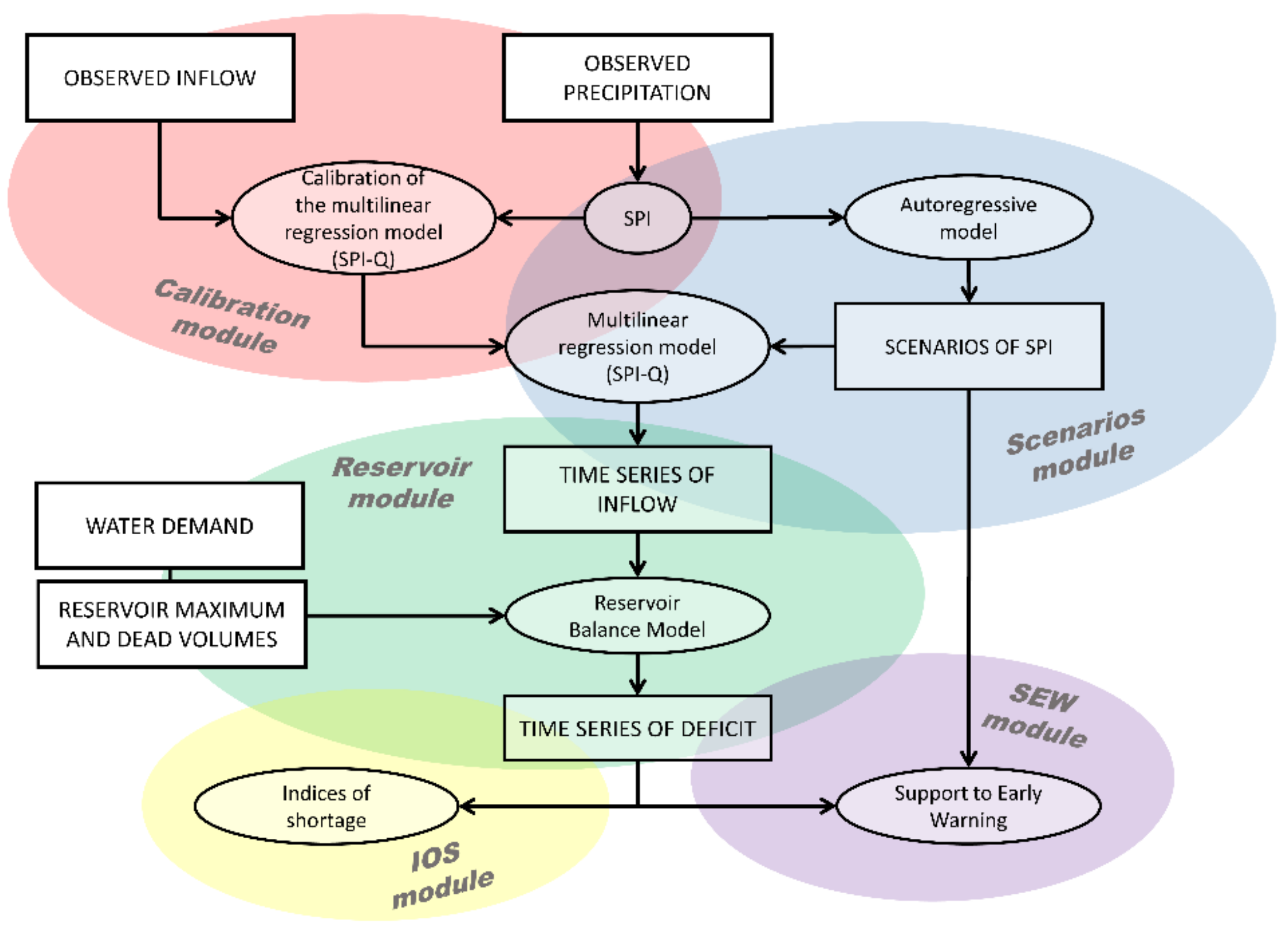
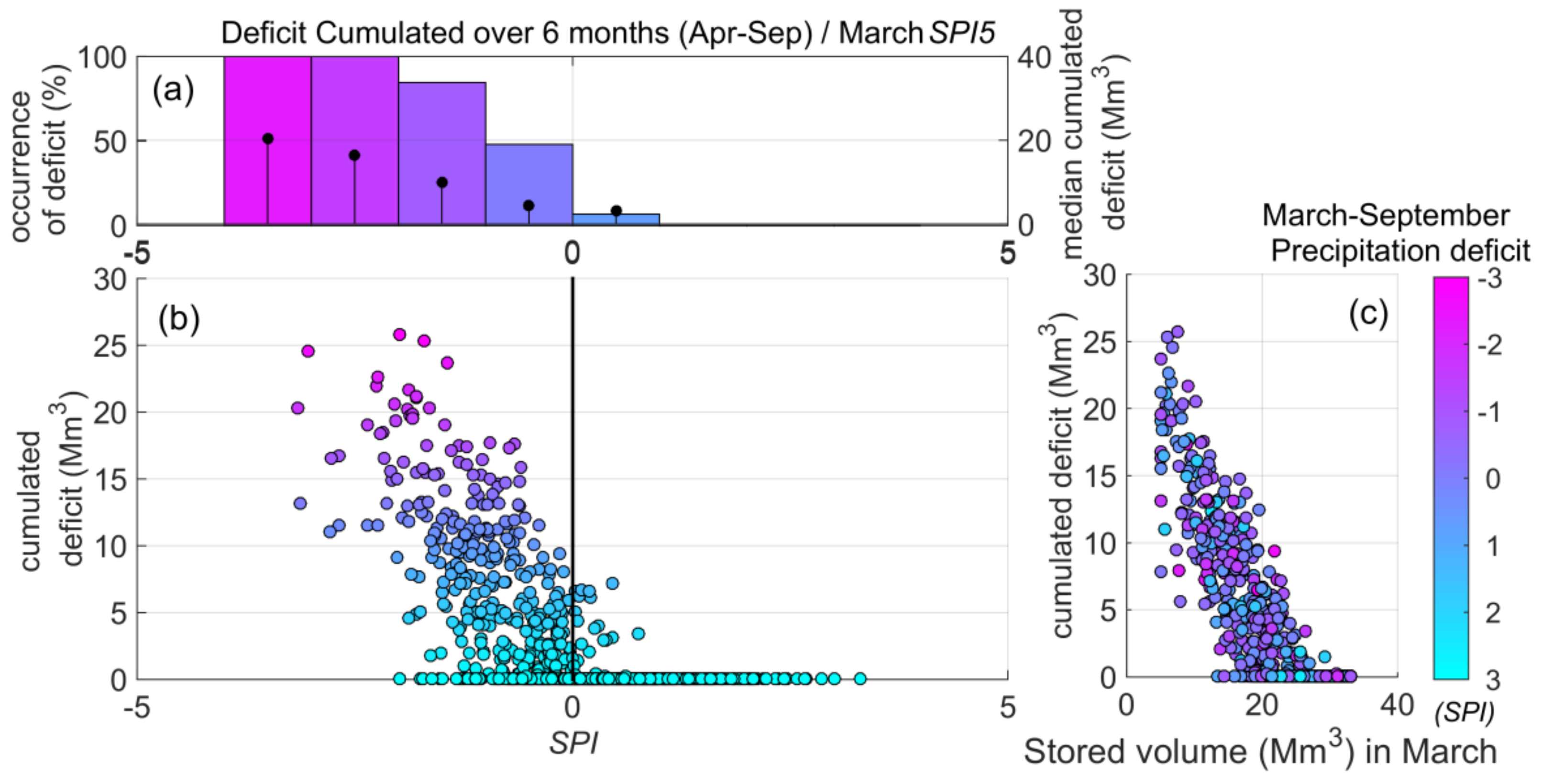
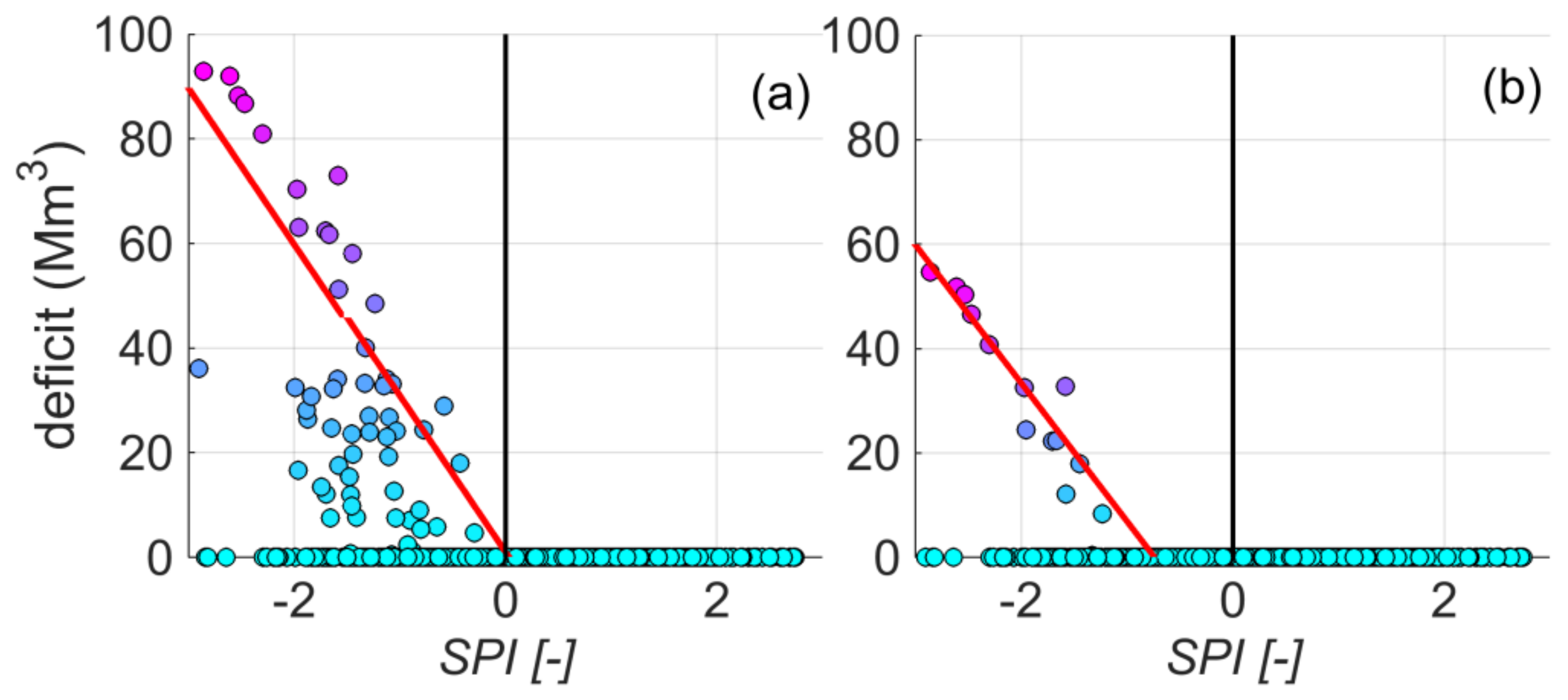
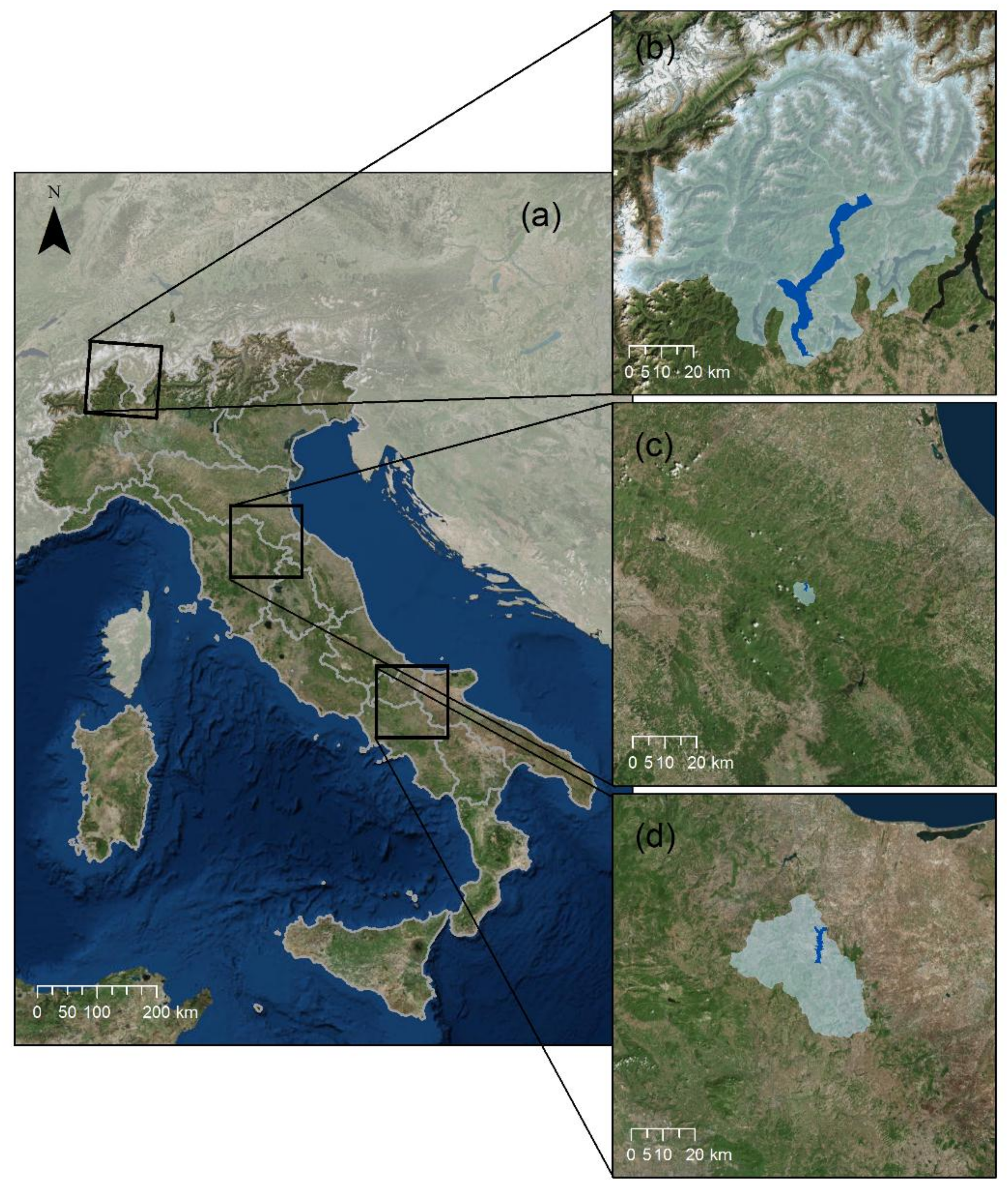
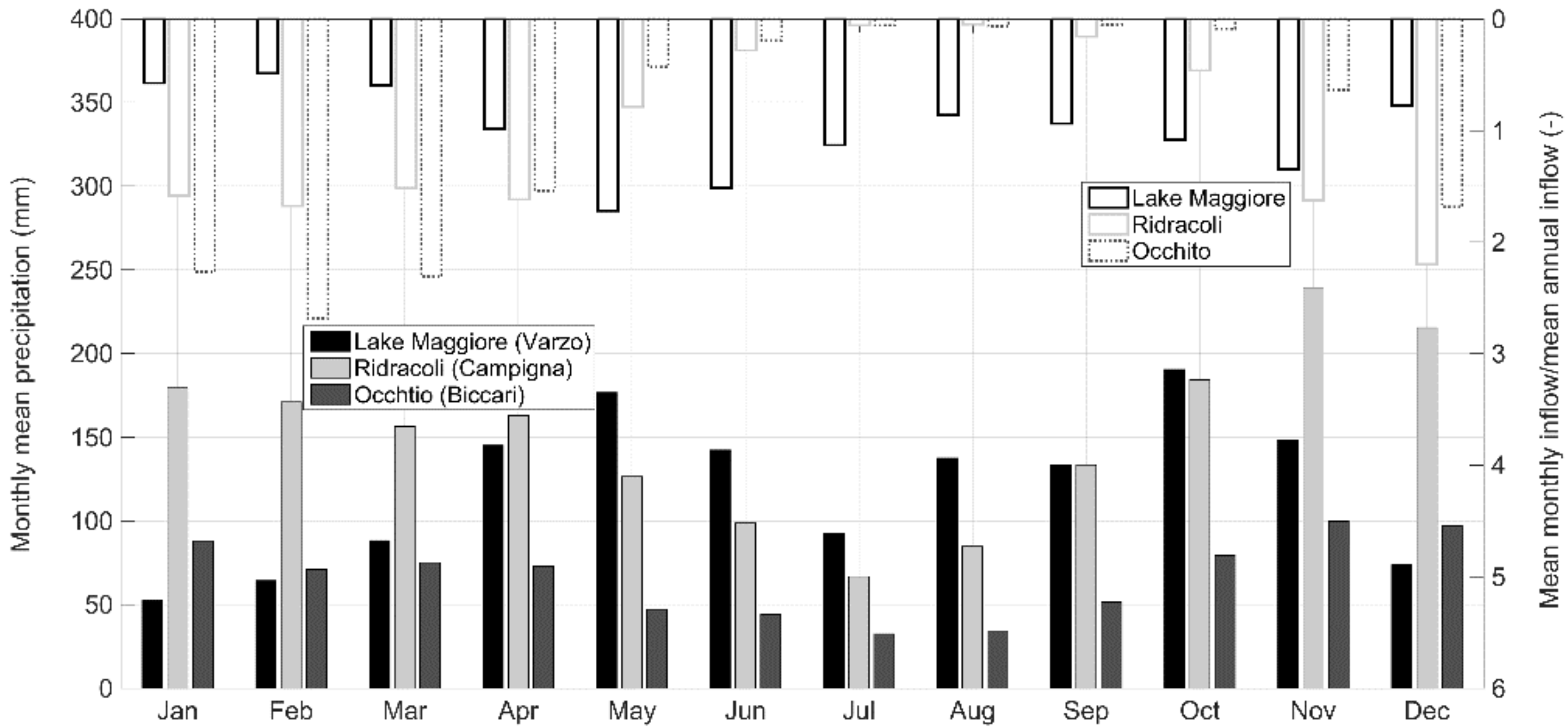
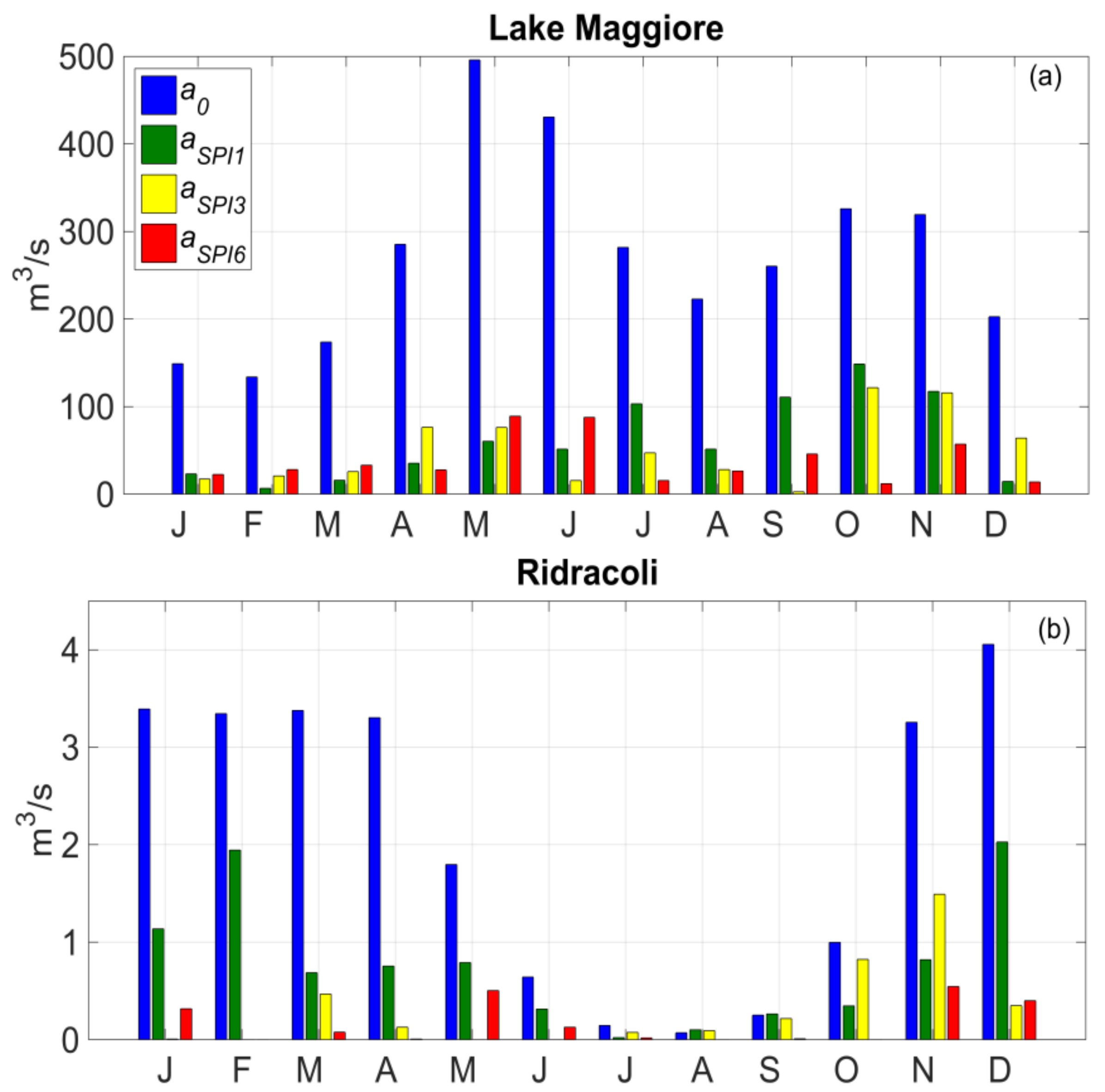
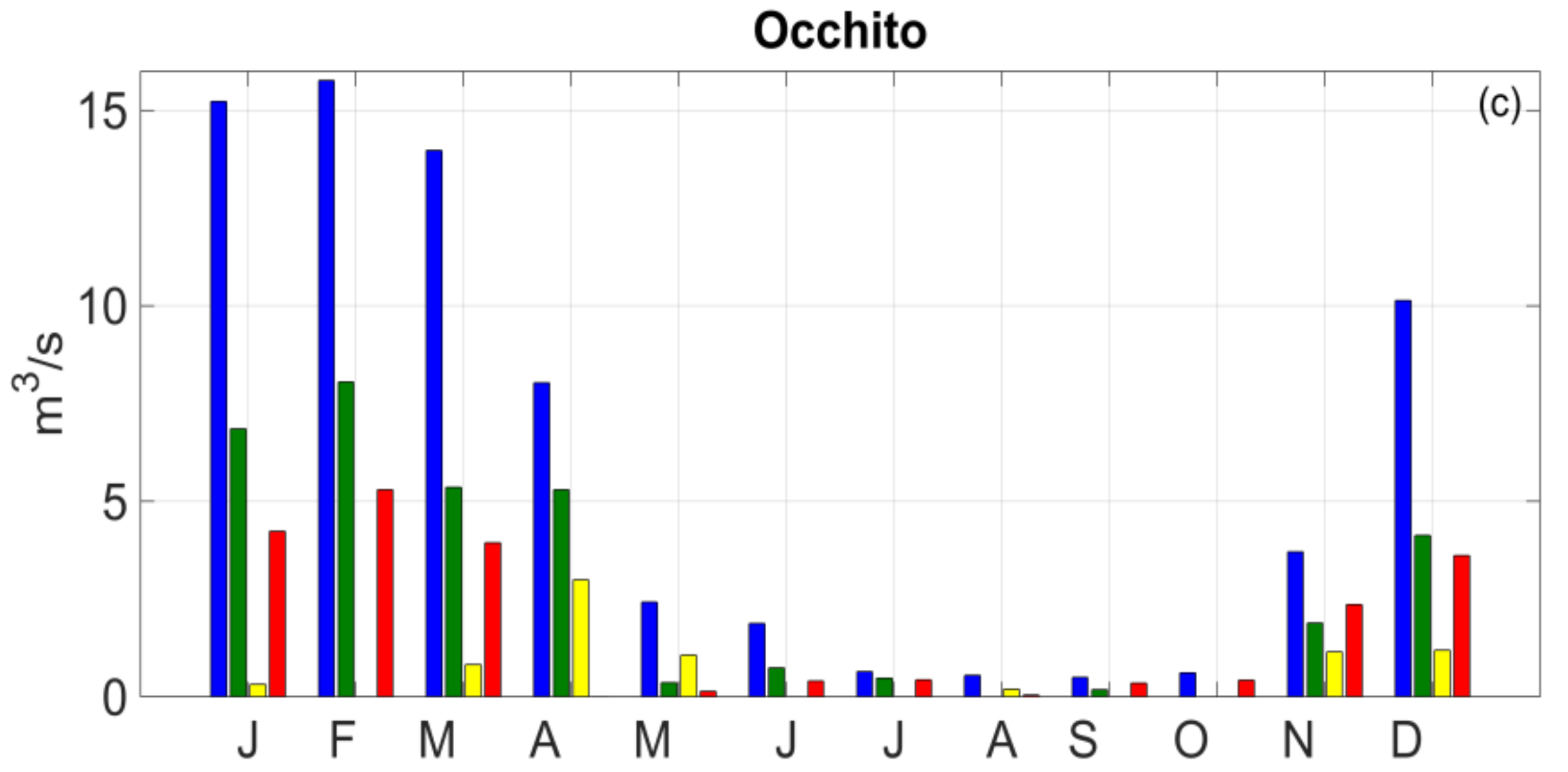
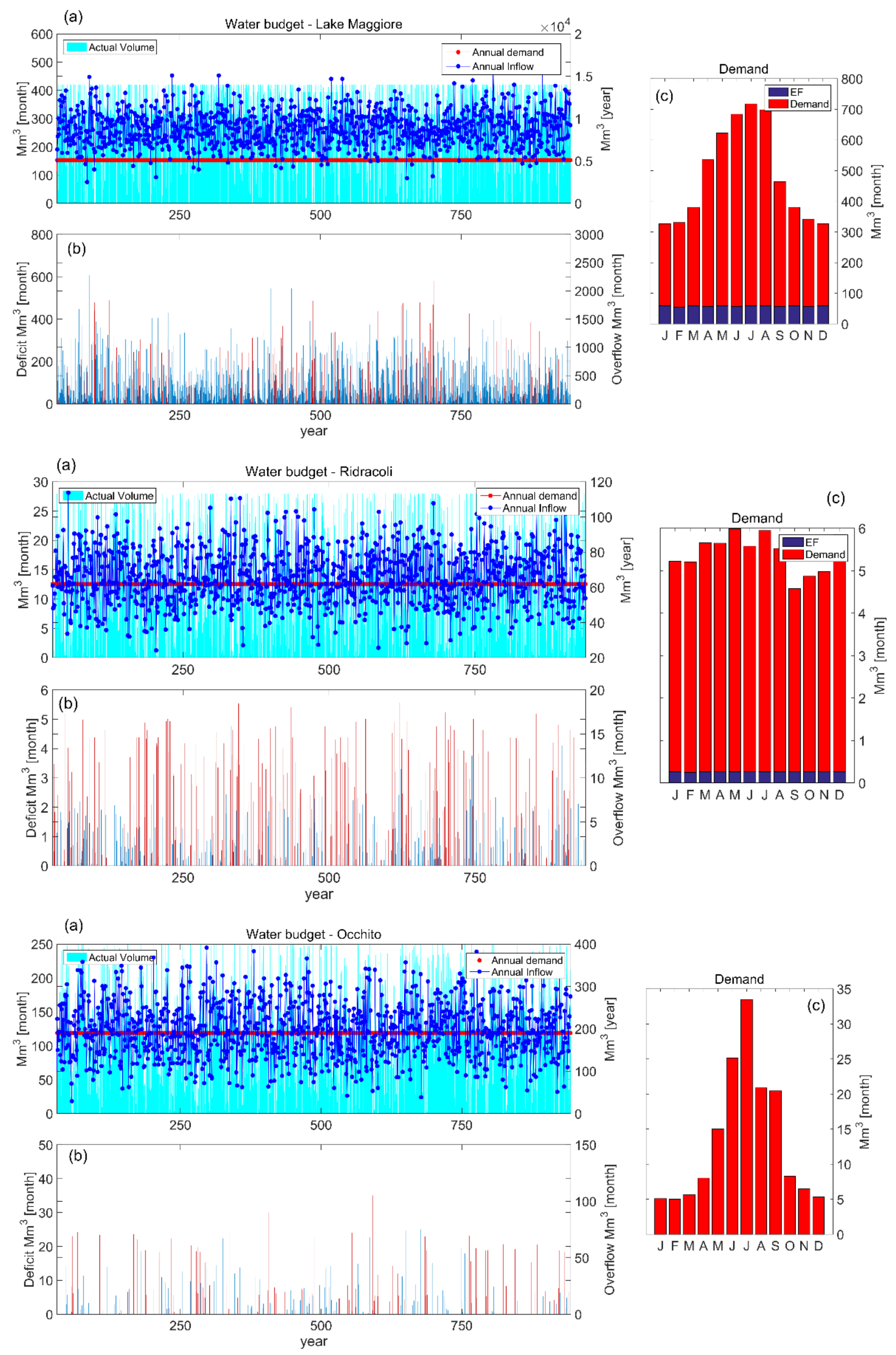
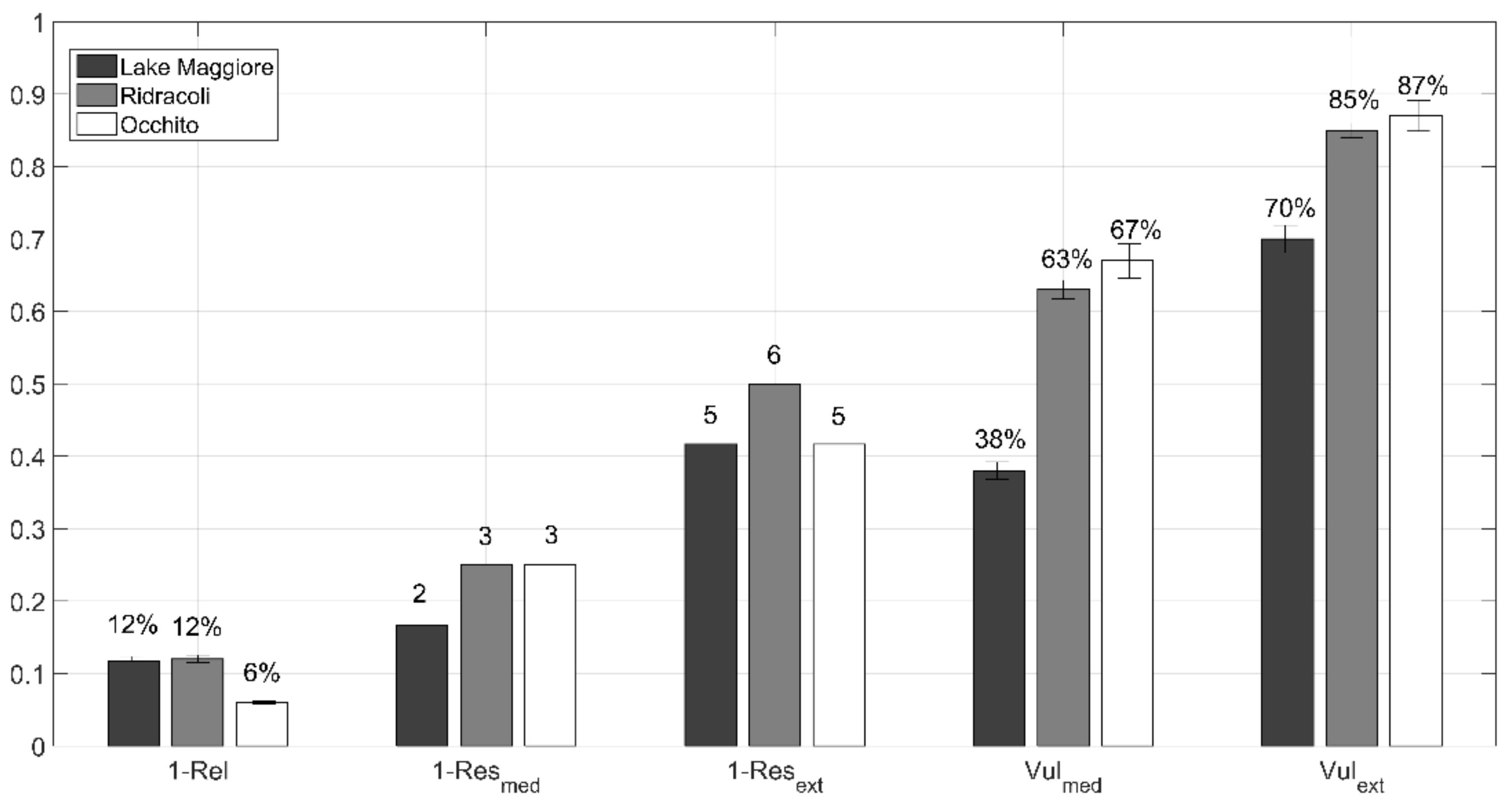
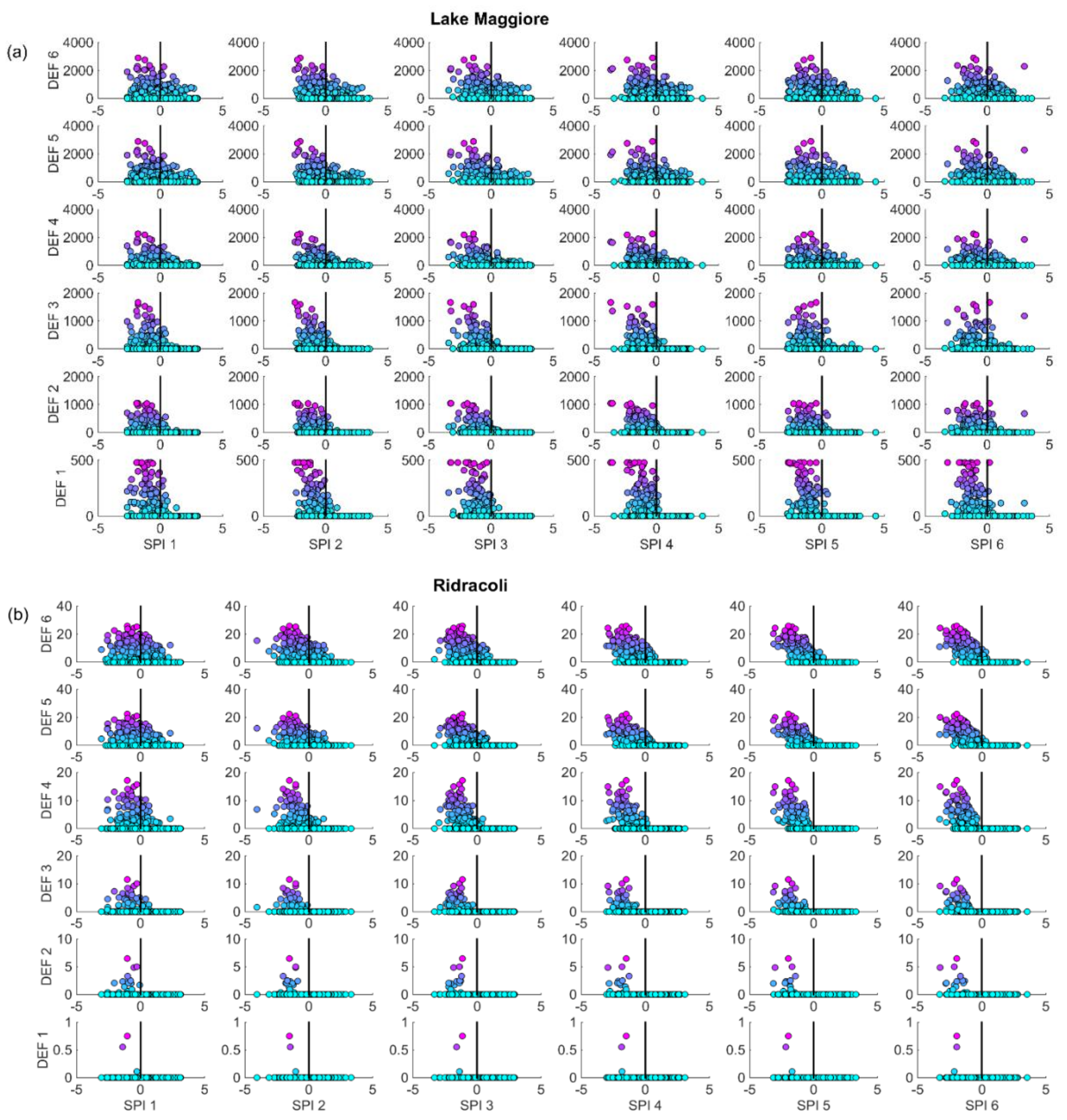
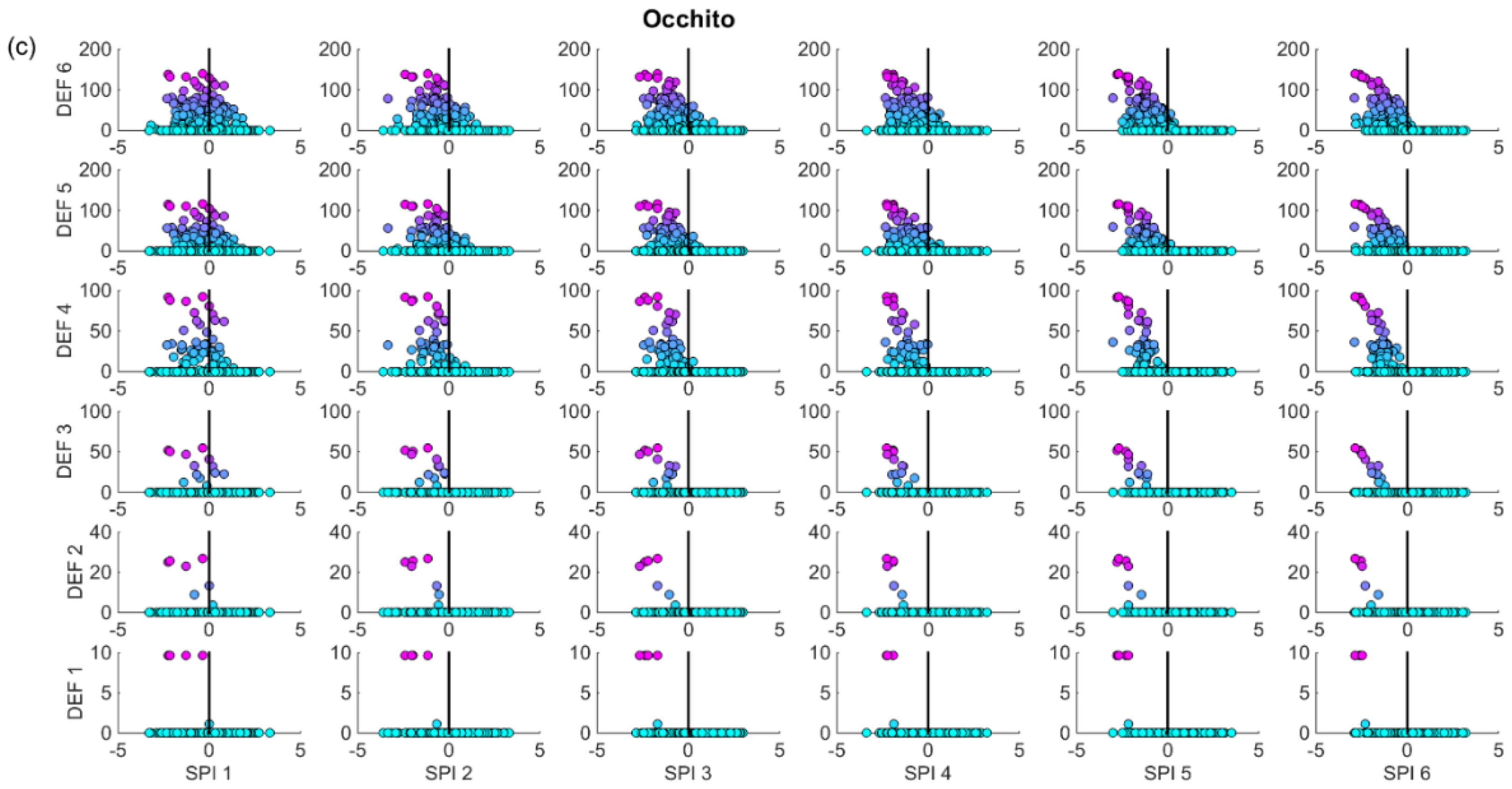
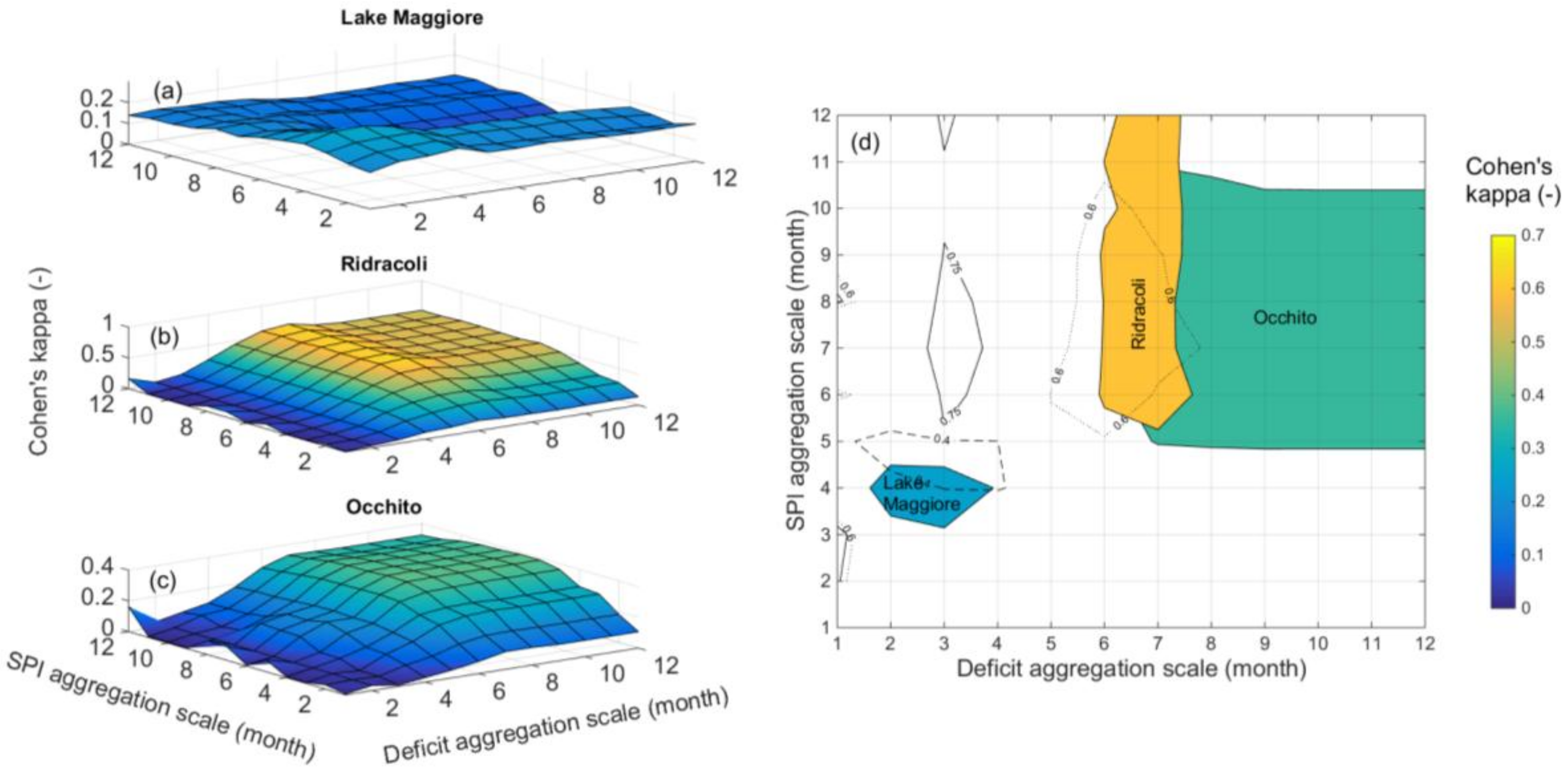
| RESERVOIR | |||
|---|---|---|---|
| Lake Maggiore | Ridracoli | Occhito | |
| Koppen-Geiger climate classification | Alpine (Temperate cold) | temperate cool | Mediterranean (temperate hot) |
| Mean altitude of the watershed basin (m asl) | 1314 | 893 | 583 |
| Watershed basin (km²) | 6660 | 36 | 1008 |
| Number of rain gauges stations | 9 | 4 | 2 |
| Rainfall data availability | 1951–2012 | 1946–2010 | 1950–2010 |
| Inflow data availability | 1995–2014 | 1987–2010 | 1982–2007 |
| Mean Annual Inflow MAI (Mm3) | 8536.8 | 64.1 | 162.4 |
| Reservoir maximum storage capacity RMC (Mm3) | 250 | 28 | 250 |
| Mean Annual Demand MAD (Mm3) | 5096 | 61.7 | 158.2 |
| MAI/MAD [-] | 1.68 | 1.04 | 1.03 |
| RMC/MAI [-] | 0.03 | 0.44 | 1.54 |
| RMC/MAD [-] | 0.05 | 0.45 | 1.58 |
| RESERVOIR | |||
|---|---|---|---|
| Lake Maggiore | Ridracoli | Occhito | |
| r2 | 0.84 | 0.93 | 0.83 |
| Root Mean Square Error (m3/s) | 7.2 × 101 | 5.2 × 10−1 | 3.4 × 100 |
| Mean Absolute Error (m3/s) | 4.6 × 101 | 3.4 × 10−1 | 2.0 × 100 |
| Mean Bias (m3/s) | 6.3 × 10−1 | 7.8 × 10−3 | 2.4 × 10−1 |
| Mean Bias/Reservoir capacity (%) | 7.9% | 0.2% | 3.0% |
| Mean Bias/Annual Mean Total Inflow (%) | 0.2% | 0.4% | 4.7% |
| RESERVOIR | ||||
|---|---|---|---|---|
| Lake Maggiore | Ridracoli | Occhito | ||
| Cohen’s k | Maximum | 0.271 | 0.648 | 0.390 |
| Predictor SPI | SPI4 | SPI6 | SPI7 | |
| Forecast time window | DEF3 | DEF7 | DEF8 | |
| Regression coefficient | Maximum | 0.449 | 0.657 | 0.945 |
| Predictor SPI | SPI4 | SPI5 | SPI6 | |
| Forecast time window | DEF2 | DEF6 | DEF3 | |
© 2018 by the authors. Licensee MDPI, Basel, Switzerland. This article is an open access article distributed under the terms and conditions of the Creative Commons Attribution (CC BY) license (http://creativecommons.org/licenses/by/4.0/).
Share and Cite
Romano, E.; Guyennon, N.; Duro, A.; Giordano, R.; Petrangeli, A.B.; Portoghese, I.; Salerno, F. A Stakeholder Oriented Modelling Framework for the Early Detection of Shortage in Water Supply Systems. Water 2018, 10, 762. https://doi.org/10.3390/w10060762
Romano E, Guyennon N, Duro A, Giordano R, Petrangeli AB, Portoghese I, Salerno F. A Stakeholder Oriented Modelling Framework for the Early Detection of Shortage in Water Supply Systems. Water. 2018; 10(6):762. https://doi.org/10.3390/w10060762
Chicago/Turabian StyleRomano, Emanuele, Nicolas Guyennon, Andrea Duro, Raffaele Giordano, Anna Bruna Petrangeli, Ivan Portoghese, and Franco Salerno. 2018. "A Stakeholder Oriented Modelling Framework for the Early Detection of Shortage in Water Supply Systems" Water 10, no. 6: 762. https://doi.org/10.3390/w10060762
APA StyleRomano, E., Guyennon, N., Duro, A., Giordano, R., Petrangeli, A. B., Portoghese, I., & Salerno, F. (2018). A Stakeholder Oriented Modelling Framework for the Early Detection of Shortage in Water Supply Systems. Water, 10(6), 762. https://doi.org/10.3390/w10060762




